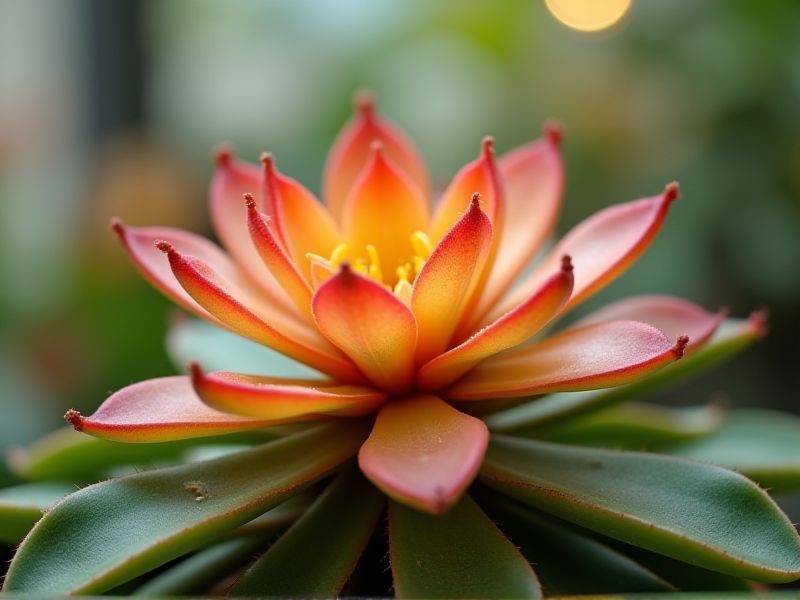
Indoor succulent plants that flower not only enhance the aesthetic appeal of your space but also require relatively low maintenance. Varieties such as the Christmas Cactus (Schlumbergera), which blooms in vibrant red, pink, or white during the holiday season, bring seasonal cheer. Another popular choice is the Aloe Vera, known for its healing properties, which can produce tall stalks with tubular yellow or orange flowers when adequately cared for. The Echeveria species, with its rosette shape, can also surprise you by blossoming with pendulous flowers in shades of pink or yellow. To encourage flowering, ensure your succulents receive adequate sunlight and a well-draining potting mix to thrive indoors.
List of some Succulent plants that flower indoors
- Christmas Cactus (Schlumbergera bridgesii)
- Crown of Thorns (Euphorbia milii)
- Jade Plant (Crassula ovata)
- Aloe Vera (Aloe barbadensis miller)
- Zebra Plant (Haworthiopsis fasciata)
- Flaming Katy (Kalanchoe blossfeldiana)
- String of Pearls (Senecio rowleyanus)
- Burro's Tail (Sedum morganianum)
- Orchid Cactus (Epiphyllum spp.)
- Ice Plant (Oscularia deltoides)
Important things about Succulent plants that flower indoors
Light Requirements
Succulent plants that flower indoors thrive best in bright, indirect light, which mimics their natural habitat. You should position them near a south or west-facing window to ensure they receive adequate sunlight for optimal growth and blooming. If natural light is limited, consider using full-spectrum grow lights to supplement their light needs, providing the necessary wavelengths for photosynthesis and flowering. Proper light exposure not only encourages flowering but also helps prevent common issues like etiolation, ensuring your indoor succulents remain healthy and vibrant.
Watering Needs
Succulent plants that flower indoors typically require less frequent watering compared to other houseplants, as they store water within their leaves. You should ensure the soil dries out completely between watering sessions to prevent root rot. During the blooming phase, which can be influenced by factors such as light and temperature, these plants may need slightly more water to support flower development. Remember to use well-draining potting mix to facilitate proper drainage, allowing your indoor succulents to thrive and showcase their vibrant blooms.
Soil Type
The ideal soil type for indoor flowering succulent plants is a well-draining, nutrient-rich mix that typically includes ingredients such as perlite, coarse sand, and organic matter. This combination ensures that excess moisture drains quickly, preventing root rot, a common issue with succulents that thrive in arid conditions. When potting your succulents, you should opt for pots with drainage holes to further enhance soil aeration and moisture control. Regularly checking the soil moisture level will help you understand when to water, ensuring your indoor succulents remain healthy and vibrant while producing beautiful blooms.
Temperature Preferences
Succulent plants that flower indoors thrive in warm environments, ideally maintaining temperatures between 60degF and 80degF (15degC to 27degC). They require a stable climate, where sudden temperature fluctuations can hinder their growth and blooming. Providing sufficient warmth and bright, indirect sunlight is essential for healthy flowering. To ensure your indoor succulents flourish, monitor the room temperature, avoiding cold drafts and chilly spots that can shock these heat-loving plants.
Fertilization Schedule
For your indoor succulent plants that flower, a balanced fertilization schedule is essential to support healthy growth and vibrant blooms. Utilize a diluted, water-soluble fertilizer formulated for cacti and succulents every four to six weeks during the growing season, typically spring and summer. This ensures your plants receive the necessary nutrients, such as nitrogen, phosphorus, and potassium, to enhance flower production. Monitor your succulents for signs of over-fertilization, like leaf burn, and adjust your application frequency as needed to maintain optimal health.
Pollination Methods
Succulent plants that flower indoors often rely on a combination of self-pollination and insect assistance for reproduction. To enhance pollination, consider attracting pollinators like bees and butterflies by placing flowering succulents in bright, sunny areas. Hand-pollination can be effective; simply transfer pollen from the anthers to the stigma using a small brush or cotton swab. Ensuring optimal humidity and light conditions will not only promote flowering but also improve your plants' chances of producing viable seeds.
Flowering Season
Succulent plants such as Echeveria, Aloe, and Sedum can bring vibrant colors and intriguing shapes to your indoor space during their flowering season. Typically blooming in late winter to early spring, these succulents may produce stunning tubular flowers that attract pollinators even in the confines of your home. To encourage flowering, ensure they receive adequate sunlight and only water when the soil is completely dry, mimicking their natural arid environments. Your indoor gardening experience can be enriched by the beautiful blossoms of these hardy plants as they effortlessly combine aesthetics with low maintenance.
Pot Selection
Choosing the right pot for your indoor flowering succulents is crucial for their health and aesthetic appeal. Opt for a pot with adequate drainage holes to prevent overwatering, which can lead to root rot. Consider using terracotta pots, known for their breathability, allowing moisture control suitable for succulent growth. A decorative container can enhance your home decor while providing the perfect environment for your succulents to bloom beautifully.
Common Pests
Succulent plants that flower indoors often attract common pests such as aphids, mealybugs, and spider mites, which can hinder their growth and blooming potential. These pests thrive in warm, dry environments, making your indoor plants particularly susceptible. Regularly inspecting your succulents for signs of infestation, such as sticky residue or webbing, is crucial to maintaining their health. Implementing organic pest control methods, like neem oil or insecticidal soap, can effectively protect your flowering succulents from these unwanted visitors.
Pruning Techniques
Pruning succulent plants that flower indoors is essential for maintaining their health and promoting new growth. Regularly removing dead or damaged leaves encourages airflow and reduces the risk of pests and diseases. You should also trim back leggy growth to encourage a fuller shape and enhance flowering potential. Employing sharp, sterilized tools can ensure clean cuts, minimizing stress on the plant and facilitating rapid healing.
